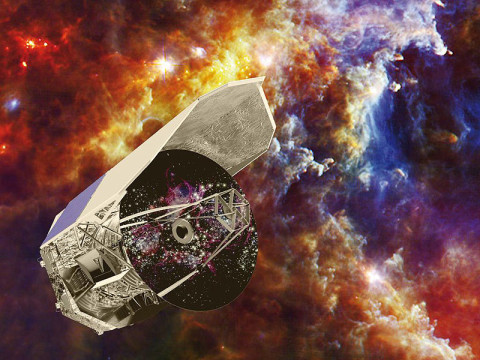Written by Whitney Clavin
NASA’s Jet Propulsion Laboratory
 Pasadena, CA – The Herschel space observatory is expected to exhaust its supply of liquid helium coolant in the coming weeks, after spending more than three years studying the cool universe and surpassing the expectations of the international team of scientists involved.
Pasadena, CA – The Herschel space observatory is expected to exhaust its supply of liquid helium coolant in the coming weeks, after spending more than three years studying the cool universe and surpassing the expectations of the international team of scientists involved.
Herschel is a European Space Agency (ESA) mission with important participation from NASA. The telescope was launched on May 14th, 2009. With a main mirror 11.5 feet (3.5 meters) across, it is the largest, most powerful infrared telescope ever flown in space.

To make such sensitive far-infrared observations, the detectors of the three science instruments — two cameras/imaging spectrometers and a very high-resolution spectrometer — must be cooled to a frigid minus 456 degrees Fahrenheit (minus 271 degrees Celsius), close to absolute zero. They sit on top of a tank filled with superfluid liquid helium, inside a giant thermos flask known as a cryostat.
The superfluid helium evaporates over time, gradually emptying the tank and determining Herschel’s scientific life. At launch, the cryostat was filled to the brim with more than 606 gallons (2,300 liters) of liquid helium, weighing 739 pounds (335 kilograms), for 3.5 years of operations in space.
Herschel has made extraordinary discoveries across a wide range of topics, from starburst galaxies in the distant universe to newly forming planetary systems orbiting nearby young stars.
However, all good things must come to an end, and engineers believe that almost all of the liquid helium is now gone.
It is not possible to predict the exact day the helium will finally run out, but when it happens, confirmation will come when Herschel begins its next daily three-hour communication period with ground stations on Earth.
The science-observing program was carefully planned to take full advantage of the lifetime of the mission, with all of the highest-priority observations already completed.
In addition, Herschel is performing numerous other interesting observations specifically chosen to exploit every last drop of helium.
“When observing comes to an end, we expect to have performed over 22,000 hours of science observations, 10 percent more than we had originally planned, so the mission has already exceeded expectations,” said Leo Metcalfe, the Herschel Science Operations and Mission Manager at ESA’s European Space Astronomy Centre in Madrid, Spain.
“We will finish observing soon, but Herschel data will enable a vast amount of exciting science to be done for many years to come,” says Göran Pilbratt, ESA’s Herschel Project Scientist at ESA’s European Space Research and Technology Center in Noordwijk, the Netherlands.
“In fact, the peak of scientific productivity is still ahead of us, and the task now is to make the treasure trove of Herschel data as valuable as possible for now and for the future.”
Herschel will continue communicating with its ground stations for some time after the helium is exhausted, allowing a range of technical tests. Finally, in early May, it will be propelled into its long-term stable parking orbit around the sun.
Herschel is a European Space Agency cornerstone mission, with science instruments provided by consortia of European institutes and with important participation by NASA. NASA’s Herschel Project Office is based at NASA’s Jet Propulsion Laboratory, Pasadena, CA.
JPL contributed mission-enabling technology for two of Herschel’s three science instruments. The NASA Herschel Science Center, part of the Infrared Processing and Analysis Center at the California Institute of Technology in Pasadena, supports the United States astronomical community. Caltech manages JPL for NASA.
More information is online at http://www.herschel.caltech.edu , http://www.nasa.gov/herschel and http://www.esa.int/SPECIALS/Herschel .


